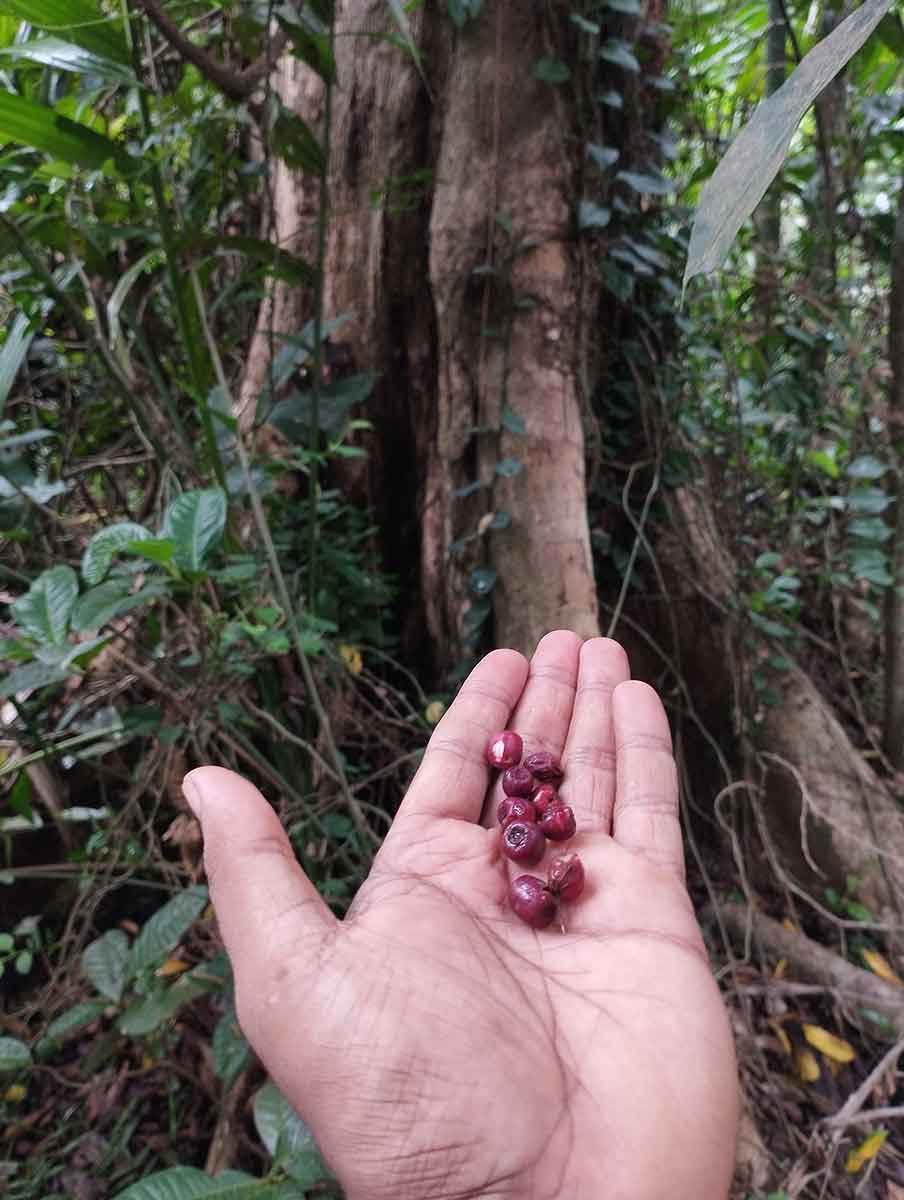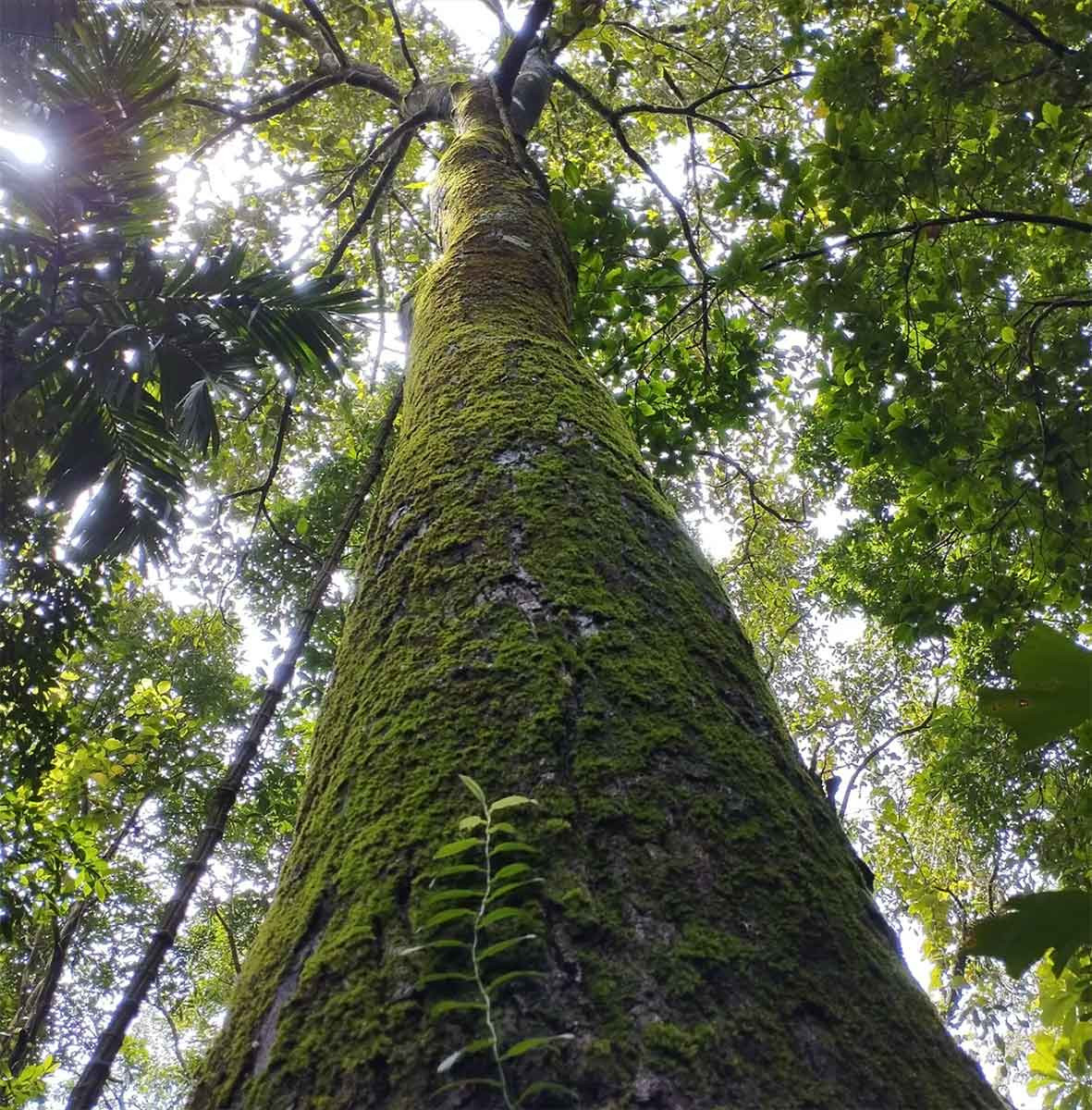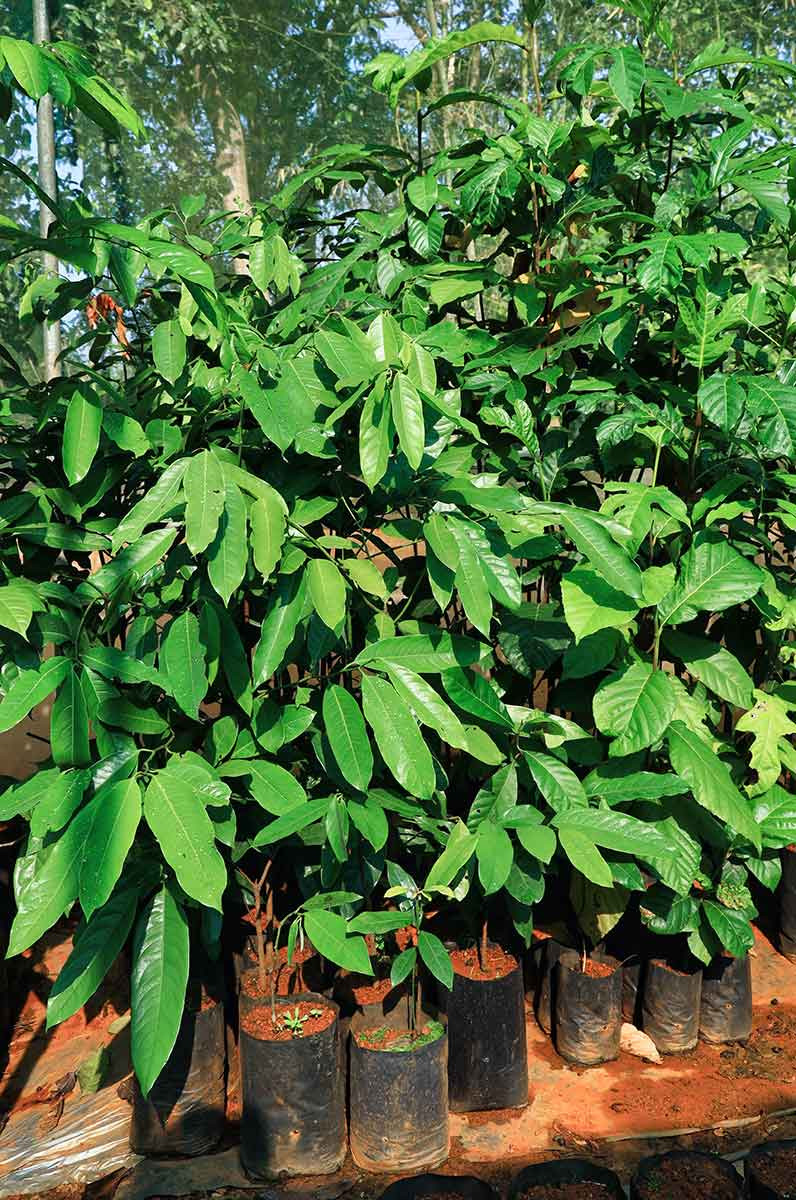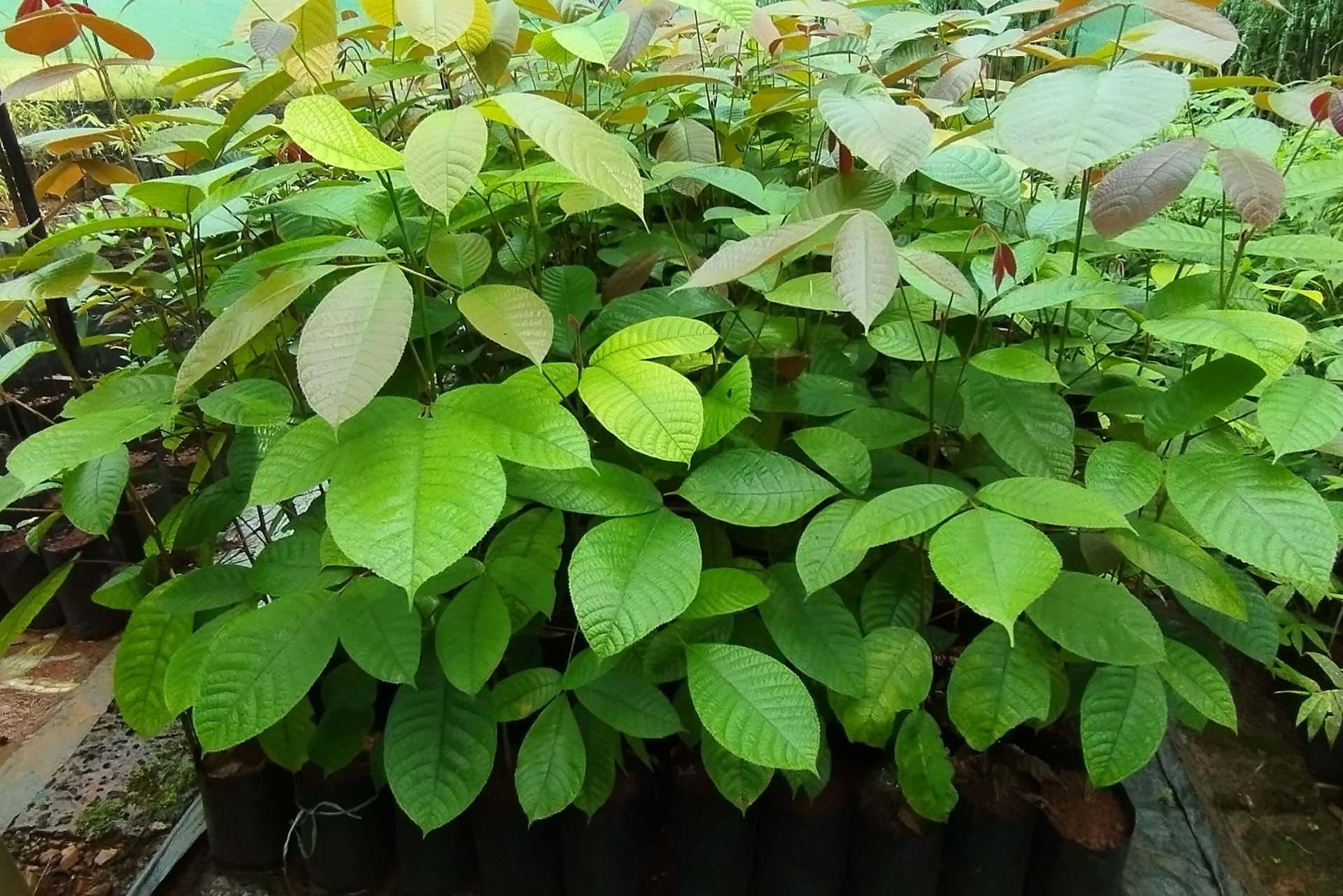Milind Patil, the proprietor of the Western Ghats Nursery, writes from his experience about the role of nurseries in restoration and the challenges in operating them.
Trees in the evergreen forests of the Western Ghats invest a lot of energy to produce colourful and fragrant flowers that can attract various life forms like beetles, bees, birds and even arboreal mammals to serve the critical role of pollinators. Such canopy celebrations may last for a few minutes to even a few weeks. Ultimately, the banquet of nectar, pollen or even anthers and petals has to accomplish the purpose of pollination.
Floral ovaries develop into seeds, and tiny green fruits appear on the branchlets. After a few weeks, they develop dark and delicious pericarps, kicking off the farewell party. A guest list, including hornbills, bats, civets, squirrels and primates, arrives to begin their gatherings. A few fallen fruits are also consumed by Barking Deer, Mouse Deer and the like. Trees produce thousands of seeds, of which some hundreds will find their way to seedling recruitment. Tough competition and a laundry list of threats close to the forest floor means that only one or two survive to become full-grown individuals.
Above is the story of an endangered canopy tree, Syzygium stocksii. In the northern Western Ghats, very few large individuals (90ft tall) of this species can be seen along the forest stream or swamp habitats. Clearing of private forest patches for agriculture and horticulture is the primary threat to the species. Local people also use its wood as timber. Natural habitats within the northern Western Ghats are facing tremendous external pressure, especially in human-dominated landscapes. There are numerous other endangered species from the IUCN Red List in Maharashtra’s Sindhudurg district: Nothopegia castanaefolia (CR), Calophyllum apetalum (VU), Vateria indica (VU), Beilschmiedia dalzellii (VU), Cryptocarya wightiana (VU), Myristica dactyloides (VU), Myristica malabarica (VU), Ochreinauclea missionis (VU), to name a few. The conservation status of locally rare species like Canarium strictum, Elaeocarpus tuberculatus, Artocarpus hirsutus, Diospyros ebenum, Diospyros sylvatica and many more are yet to be declared by IUCN or other agencies.
Intentionally set forest fires during the drier months from February to May, clear-felling of private forest patches, selective felling of a particular tree species with a desired quality, and regular harvesting of saplings and pole-sized individuals for fuelwood are additional reasons behind the diminishing diversity of trees in the northern Western Ghats. There are very few remaining old-growth primary forest patches with a minimum level of human disturbance. During the 80s and 90s, the region underwent a wave of ruthless clearcutting of private forests to produce coal, followed by decades of felling in the name of monoculture plantations such as rubber, pineapple, cashew, mango, coconut and more.
Ecosystems with such high levels of continued disturbance find it beyond their limits of natural recovery, especially within human-dominated spaces. In such cases, forest ecosystem restoration can be a vital tool in assisting the recovery of a degraded, damaged or destroyed patch of forest.
The Critical Role of Nurseries in Restoration
Restoration efforts are based on local reference sites, aka remnant forest fragments that represent the primary ecosystem with minimum human disturbance. The phase-wise removal of exotic species and introduction of native species based on reference sites can be planned. In highly degraded ecosystems with little connection to old-growth forests, relying on natural regeneration or direct seeding to recreate the density, distribution and species makeup of the local reference site will not work. This is where restoration nurseries have a critical role to play.
Raising good quality seedlings of desired species is the very foundation of forest restoration. For this, native species typical to the vegetation type, region and altitude, as evidenced by their occurrence in the reference site, are selected. The planting of locally indigenous species will restore the site's structural characteristics and functional attributes like they were before the disturbance. However, when making significant restoration commitments, restoration nurseries are often forgotten or overlooked. One of the first things to think about should be seedling and nursery specifications. This oversight may lead to the exclusion of nurseries from planning processes or the allocation of funding for restoration projects, which will mean insufficient quantity and poor quality of seedlings, resulting in failure to achieve the set restoration goals. Suppose we are planning restoration activities for 100 hectares of degraded evergreen forests in the Western Ghats: if we consider 1000 to 1200 plants per hectare, for the first year we will need around 120,000 well-hardened, vigorous saplings of various desired combinations which can survive harsh field conditions, and considering higher survival rates of planting seedlings (70 per cent), we will need additional 35,000 plants as casualty replacement in the next year.
There is a common misconception that establishing a restoration nursery and growing native plants is easy, possibly as a result of widespread agricultural and horticulture production. Delivering sufficient numbers of high-quality plants necessitates specialised knowledge and attention to a number of significant factors. Identification and collection of seeds from a particular species; understanding its nature, viability and storage life; any pre-seed sowing treatment(s) if required; appropriate media (quality and depth of a seed bed) and the best suitable conditions (temperature, humidity, shade or sunlight, irrigation regimes etc.) for germination; choosing of appropriate bag size, if seeds are sown directly in a polybag; appropriate proportions of potting media (e.g. sieved soil, sand if necessary, goat manure, decomposing leaf litter etc.); time required for germination; seed recruitment aftercare; regular cleaning and weeding; avoiding dampness and allied unhygienic conditions which otherwise may lure plant pests and diseases are a few important things which need looking after.
Connecting the Landscape
First and foremost, restoration nurseries should be set up with motives and agendas different from commercial horticultural nurseries or regular forest department nurseries, which are producing lakhs of plants for various afforestation programmes. The nursery owner or the manager must have knowledge and deep insights into the local landscape and its natural history. They must be keen observers who understand trees, plants, phenology, seed cycles and more. Phenotype is an evolutionary genetic response to external environmental conditions, and thus the life history of an individual plant must be observed and studied with its associates in its absolute environment.
The collection of seeds, especially those which are locally rare, is in itself a tough task. Seeds must be collected from more than one individual of a particular species to maintain genetic diversity. Collecting a maximum number of seeds from very few neighbouring individuals should be avoided. In addition, 70 to 80 per cent of the seeds should be left to let them grow on their own. Generally, it is better to avoid seed collection from places or habitats where there are maximum chances of their natural recruitment and survival. Natural regeneration needs to be encouraged.
There is no thumb rule for how many individual trees can be chosen for seed collection or how far away they can be from the restoration site or reference site. In my opinion, maximum preference must be dedicated to searching for more and more individuals within a particular landscape. Relatively inaccessible or undisturbed or ‘far away’ areas from the nearest human settlement may sometimes reveal individuals of rare species.
Many evergreen trees have seed cycles at an interval of 3-5 years, also called the ‘mast’ year. In such a year, you will get a bumper seed, but in the next year, there would be no or a very low seed set. This can also be correlated to the production of viable seeds. Collected seeds should be labelled, mentioning the date, seed collection site, physiographic conditions, associated species and other details.
Knowing the Needs of Different Species
Let me give you an interesting example. Generally, seeds of Myristicaceae are recalcitrant in nature with a very short viability of a few days. Seeds can be stored for 2 to 3 weeks if kept in moist gunny bags in cool and dry shade conditions. Their viability is highly sensitive to the moisture percentage and sudden fluctuations in the moisture level or temperature leads to failure of seed germination, even though germination of most of the Myristicaceae starts after the second month from the date of sowing.
Similar is the case for Clusiaceae, seeds are also recalcitrant in nature and sensitive to the moisture percentage. Interestingly, seeds of Garcinia gummi-gutta take a minimum of 10 months to 1 year in the nursery. But if you carefully remove its seed coat and then keep it for germination, it will sprout within 2 to 3 months.
Secondary hardening is a broad subject. Regular nurseries bring out saplings from the poly house or greenhouse into the sun and start gradually declining their irrigation. However, such practices lead to greater mortality in typical evergreen species seedlings. It is better to keep them under a partial shade of tall evergreen trees. Diffused sunlight and a relatively stable climate below the tree canopy can help them acclimatise to the environment.
The root-shoot ratio is another important topic. Many evergreen tree seedlings show relatively slow growth in the shoot portion but their roots are two to three times more vigorous. e.g., root growth in Mammea suriga or Mesua ferrea (Calophyllaceae) is almost three times faster than the shoot growth. In such cases, seedlings should be raised in taller polybags, say a minimum of 8 inch by 12-inch size and field plantation should be done within 1.5 to 2 years though the shoot may look smaller in size. Excessive root coiling in polybags could also suppress root vigour.
The Route to Survival for Nurseries
Restoration nurseries can organise educational and awareness programmes about locally rare plant species, about restoration and conservation for schools, universities, forest department staff and local people in general. They can also generate local livelihood opportunities by providing employment.
Financial support is often the primary barrier for establishing or maintaining restoration nurseries, as compared to regular commercial nurseries. Many times, restoration nurseries keep their seedling prices low to encourage the public and other land managers to invest/buy these native plants. But the actual costs for raising and taking care of rare, threatened plant species is comparatively on the higher side. Many plant enthusiasts and plantation programme managers are reluctant to invest time, money, and effort into seedlings when little or no short-term financial gains or visible impacts are anticipated.
Instead of producing according to a contract, restoration nurseries typically grow their stock speculatively based on expected demand. Here, the speculations and guesswork may create higher risk in the event that demand declines due to funding issues or other resource constraints. Now the seedling stock which is ready for field plantation may remain in the nursery itself. In such situations, the maintenance cost for plants increases while waiting for the commencement of the next planting season. It also adversely affects plant growth as they are again forced to spread their roots in the container itself.
It is high time we understood and acted on the need for good restoration nurseries. Their survival essentially equates to the survival of rare plant species in the wild. The progress and success of any restoration programme depend on the survival of the efforts taken by restoration practitioners. It is necessary to establish well-organised, well-managed nurseries to achieve SMART (Specific, Measurable, Achievable, Relevant, Time-bound) goals of ecosystem restoration. A network of restoration nurseries across the country should be stabilised and strengthened. More crucially, dedicated investment should be encouraged by establishing conditions that allow for long-term planning and operation of these micro units.
Visit the Ecological Restoration Alliance website to learn more.










